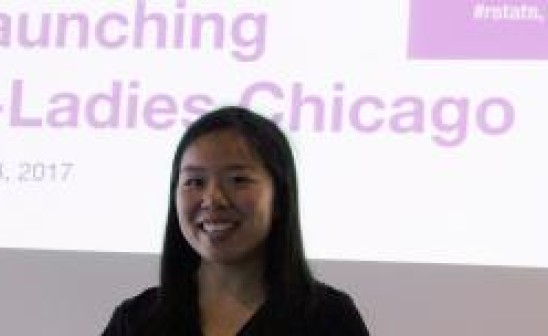A research project about Detroit helped Angela Li launch a career in spatial data science

Economics major turned spatial data scientist
Even when students think they know exactly where their career is heading, sometimes a project or a professor steers them in an entirely new direction. That was the case for Angela Li, AB’18. Li earned dual bachelor’s degrees in economics and public policy, but for the last year, she has been making a name for herself in the world of spatial data science.
How it all began
As a fourth year, Li was working on a thesis studying how the demolition of abandoned buildings in Detroit during the recession affected home prices and quality of life. “I was coming at it from an economics perspective but I needed tools to understand the data,” Li says.
She found that cleaning larger data sets manually in order to create models to predict outcomes was laborious and provided her with limited insights. So Li’s advisor, Luc Anselin, the Stein-Freiler Distinguished Service Professor of Sociology and the College, and the director of the Center for Spatial Data Science, suggested she learn R to explore the data.
R is an open-source programming language for statistical computing and graphics that is widely used in spatial data science to rapidly generate and adjust statistical models. “I had no experience in computer science but Luc inspired me to learn it,” she says.
Li began working with the language and in a few months she had learned the basics. She found the experience isolating. “Trying to teach yourself to code is hard when you have no one to tell you what you should or shouldn’t do,” she says. She looked for a group to join, and found a global organization called R-Ladies started by women using the programming language, but they didn’t have a chapter in Chicago.
So Li started her own.
A year and a half later, R-Ladies Chicago has held 20 events and attracted more than 800 members. The events range from networking opportunities, to tutorials and workshops, and are attended by a range of women, from IT professionals and data scientists, to stay-at-home mothers, and coding hobbyists.
“Learning R in a community has been great,” she says. It helped her improve her own programming skills while developing a network of women working in the same space. She also shares what she learns on Twitter and posts R resources on GitHub and other programming sites to spread knowledge about applications of the language.
UChicago’s new R Spatial Advocate
All of this work stemmed from her economics thesis project, but it ultimately led her to an unexpected career path. Anselin was so impressed by Li’s efforts that when she graduated he hired her at the Center for Spatial Data Science as the center’s new “R Spatial Advocate.”
“By her senior year I could see how enthusiastic she was about the statistical environment, and her work with R-Ladies,” Anselin says. Anselin was especially drawn to Li’s investment in creating a community around R programming. “It’s about more than the software for her,” he says. “She’s addressing the lack of women in this field.”
Li now spends her days teaching faculty, students, visiting scholars, and policy makers how to work with spatial data using R and other data science techniques. She also hosts hackathons and one-off trainings to demystify open source software, and is helping to develop to new packages and add-ons for using R in spatial data analysis. “Because it’s an open source software, anyone can contribute,” she says. “It’s very democratic.”
Li believes her initial lack of computer science experience gave her an advantage on this journey. “I can sympathize with people who come from a non-technical background,” she says. She notes that R is uniquely designed to help researchers to use programming to study spatial problems like population commuting patterns, the spread of disease, or the growth and decay of neighborhoods.. By teaching students and faculty how to use R when working with spatial data, she’s helping them accelerate their research and to improve the interpretation of their results. “I ended up in R not because I love programming, but because I love the people I met,” she says. “I’m lucky to have the chance to be a part of this community.”
Anselin notes that Li is a great role model for students who have a similar curiosity about data science, whether they have experience in technology or not. “Most of what Angela knows about programming is self-taught,” he says. “If you have the drive and interest, anyone can do it.”
